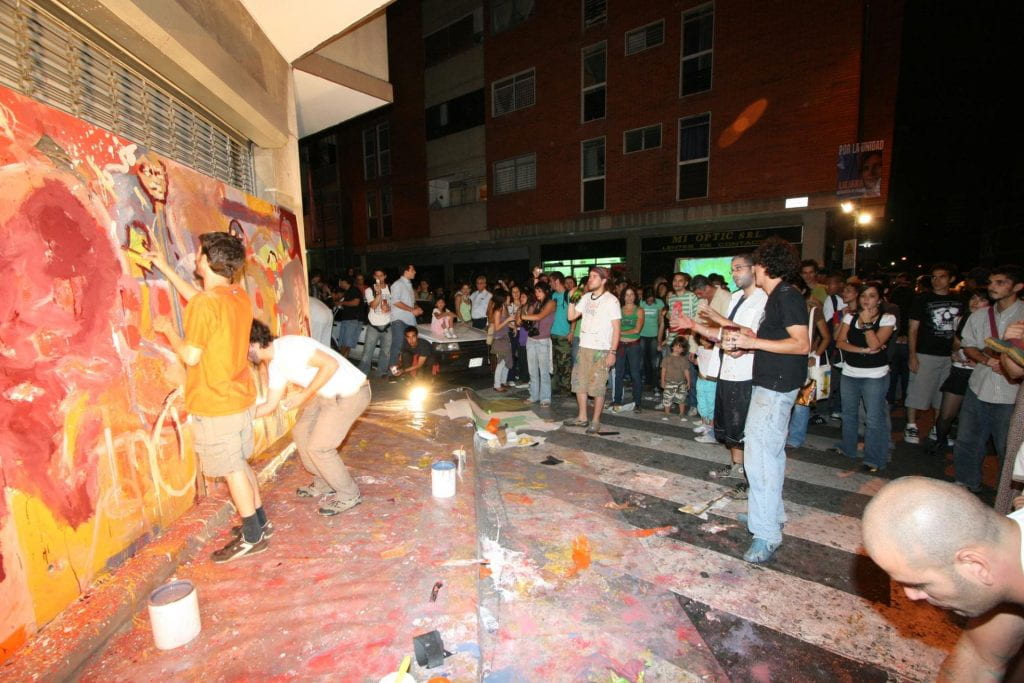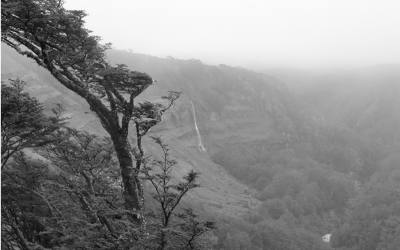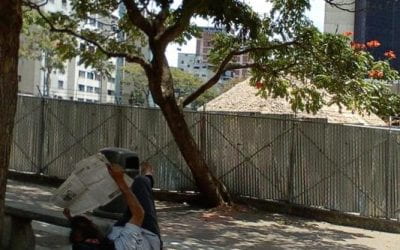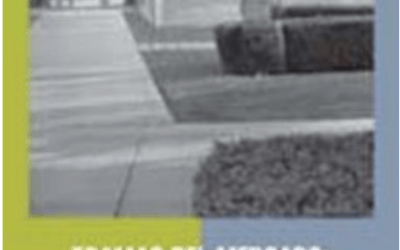Culture in Caracas
The New Institutions of Bolivarian Venezuela
In 2002, I visited Venezuela with a friend from Mexico City. Among the tourist attractions in Caracas that I took him to see was the Museo de Arte Contemporáneo Sofía Imber (known since 2006 as the Museo de Arte Contemporáneo de Caracas or MACC). I had often sang the praises of this venerable institution, one of the first museums in Latin America to focus on postwar art and which included in its collection works by Picasso, Matisse, Miró, and Fontana, alongside Venezuelan masters. Wanting the experience to be truly urban, I decided to take him on the Metro, which, like the museum, had for a long time been a source of pride among caraqueños.
We set off on our visit on July 24, a holiday. It seemed like a good day to travel by Metro because it would not be too crowded, and the ride did indeed go smoothly. As soon as we arrived at the Bellas Artes station, however, something seemed terribly amiss. The plaza that stood between the museum and the station was all but abandoned. Feeling deeply uneasy, we clutched our wallets and bolted to the museum. As we stood outside Parque Central, a modernist building complex that houses the tallest buildings in South America, we were startled by a projectile, which landed with a thud at my feet—the pit of a mango, which had been thrown at us from above. In a state of panic, we went inside, but the museum itself did little to relieve our anxiety. The galleries were in disarray, and some were empty and unlit. We did not see any security guards around, even at the inner entrances that connected the museum to the public spaces in the building, which were dark and ominous. After a very short visit, we rushed to the nearby Hilton and took a cab back home, foregoing the visits to the Galería de Arte Nacional and the Museo de Bellas Artes that I had originally planned.
My experience at that museum that day was symptomatic of the crisis that enveloped Venezuelan culture at the turn of the millennium. Among the conditions that led Chávez’s critics to accuse the president of a willful neglect of the country’s artistic patrimony were the disappearance Matisse’s Odalisque in Red Pants from the MACC; his abrupt dismissal of Sofía Imber, along with all the directors of other cultural institutions, and the eventual removal of her name from the museum; the vandalism of public works of art that had left sculptures by Venezuelan masters Jesús Rafael Soto and Alejandro Otero dismantled and a statue of Christopher Columbus in pieces; the standardization of the logos of all the museums to a single design; the abandonment of iconic areas of the city, such as the historic center and Sábana Grande boulevard, to street vendors; and the use of the Teatro Teresa Carreño, the premier complex for the performing arts, as a political arena. Fortunately, the current situation of the arts signals some promising developments. Well publicized restorations of public art works and urban areas undertaken by the government and the increasing prominence of cultural institutions controlled by the opposition point to new directions for culture and artistic patrimony in Venezuela.
To track such changes, it is fitting to begin with the contested space of the museum, which, as an institution, has been witness to both continuity and transformation. Though there have been high profile departures, many museum staff members, including some directors, have been employed since before Chávez took office in 1998, albeit in different capacities. Recurring exhibitions, such as the Salón Pirelli (featuring emerging artists) and the Bienal de Barro de América, have taken place before and after. Nevertheless, the country’s museistic structure was notably altered by the creation of the Fundación Museos Nacionales (FMN) in 2005, which oversees the all of the country’s public museums. Whereas under previous governments, museums functioned discretely and independently, this agency has centralized their operations. Now, museum directors meet on a regular basis with the minister of culture and the president of the FMN, to discuss programming and common goals. Among the most important objectives has been to integrate the greatest number of people into the activities of museums, not only as visitors, but as active policy makers.
One of the government’s biggest challenges is to make museums coherent with its own ideology of participatory democracy. The most fervent chavistas would like to see a complete reimagining of the institution of the museum, a breaking free of the structures inherited from the past. According to the artist Oscar Sotillo, the system of museums was designed for the “distribution of the bourgeois fetish called art” and are by their very nature exclusionary; he believes that real art may be found on the streets and does not need to be legitimized by an institution. Members of the community, who voice their opinions in open forums sponsored by the government, agree that, prior to Chávez’ presidency, they felt excluded and alienated from museums. They wish now to assert their presence within these institutions, not just in attendance but also in the exhibitions themselves. Though museums have indeed mounted shows addressing particular communities and have sought numerous other ways to engage audiences, guidelines and institutional decisions are still very much being made from the top down. Furthermore, over the past few years, there has been much turnover within high-level positions, making it difficult to maintain a coherent plan of action. Recently, for example, Francisco (Farruco) Sesto, a poet and architect, was replaced as minister of culture by Héctor Soto, a veterinarian by training. This new development will surely alter existing cultural policy, and how it will play out remains to be seen. One project that has witnessed many changes of the guard is the construction of a new headquarters for the Galería de Arte Nacional, which houses the national collection of Venezuelan art, a plan that originated in 1988. It has suffered lengthy delays but, upon its inauguration sometime in 2010 or 2011, will signal a symbolic paradigm shift by moving the collections away from the building designed by Carlos Raúl Villanueva and intimately associated with the old order to a fully Bolivarian edifice. So far, however, the role of museums in the Socialism of the 21st Century remains very much a work in progress.
Given the identity crisis faced by museums, it is fitting that other public institutions have embraced more active roles in the city’s cultural life. The Centro de Arte La Estancia, financed by Petróleos de Venezuela (PDVSA), and Cultura Chacao, funded by the municipality of Chacao, from opposite sides of the ideological spectrum, have become standard-bearers for public arts venues. Occupying a historic estate in Chacao with a colonial house and three and a half acres of gardens, Centro de Arte La Estancia has been open to the public since 2004. Directed by Beatrice Sansó de Ramírez, it offers art exhibitions, performing arts events, children’s programs, and educational workshops on a daily basis and receives about 40,000 visitors per month. In addition to the activities hosted in the space, the Centro de Arte La Estancia has set up satellite centers in low-income areas and oil-producing regions and also plans cultural programs in conjunction with other agencies housed within the ministry of energy and oil (Ministerio del Poder Popular de Energía y Petróleo). It supports artists and performing arts groups in return for social outreach and plays a major role in funding the restoration of cultural patrimony throughout Venezuela. Indeed, the works of art that had been vandalized or left to deteriorate—among others, Jesús Soto’s Orange Sphere, Alejandro Otero’s Abra Solar, and Rafael de la Cova’s Colón en el Golfo Triste (the aforementioned statue of Columbus)—have been carefully restored by the Centro de Arte La Estancia, as have Sábana Grande Boulevard, Paseo Los Próceres, the historic city center, and the modernist icons Torres del Silencio. Numerous other projects of patrimonial restoration are underway throughout Venezuela as are social projects related to health and community outreach that are not directly linked to culture.
Centro de Arte La Estancia has a decidedly nationalistic focus and seeks to foment a sense collective identity that takes pride in its Venezuelan roots and traditions. Its exhibitions feature the work of well-known masters as well as historical themes, folklore, and popular arts, and these are presented in a very didactic manner. Moreover, it aspires to have an outpost highlighting Venezuelan art and culture in airport and PDVSA gas stations throughout the country. It is also in the early planning stages of two museums—one to house PDVSA’s collection of twentieth century Venezuelan art and another on the history and culture of oil. Indeed, the organization is tireless in promoting the connection between oil and national identity. According to Beatrice Sansó, “Oil forms part of our very essence.” With its diverse array of activities, ambitious goals, and seemingly endless supply of oil revenue, the Centro de Arte La Estancia has created a unique and idiosyncratic model that is making its presence felt in the lives of all caraqueños.
Cultura Chacao, a neighboring non-profit foundation, seeks a similar social impact albeit at a more local level. Its activities include operating the Centro Cultural Chacao—a space inaugurated in 2004 with a gallery and multi-purpose area that also houses the local youth orchestra—commissioning public art, hosting festivals and workshops, and overseeing other neighboring cultural centers such as the Herrera Luque library. It is also in the process of building a theater, a state of the art facility that represents and investment of almost $20 million and which will be inaugurated later this year. According to its president Diana López, the three main objectives of Cultura Chacao are to offer a wide range of cultural programming, to improve the existing infrastructure by creating new centers for culture, and, most importantly, to actively involve local communities. Cultura Chacao seeks input from its neighbors through polls and round tables that encourage easy access and constant communication. The foundation receives 85-90% of its revenue from the municipality of Chacao, a bastion of the opposition, and the rest from private donations, often neighboring corporations or embassies. Neither the federal nor the state governments contribute to its operations.
In its outreach and programming, the goals and activities of Cultura Chacao appear very similar to those of FMN and PDVSA. The institution, however, considers itself to operate along very different premises. Diana López posits that “the central government and those who share its vision have been employing cultural venues for political ends,” citing as a primary example the Teatro Teresa Carreño. Cultura Chacao, on the other hand, welcomes a variety of opinions and offers a space for debate and reflection, not doctrine. López also claims that, unlike museums and other government funded agencies whose primary mission has become to promote a socialist collective identity, Cultura Chacao respects artistic individuality. It has served as a venue for artists who feel shut out of the official exhibition circuit. The gallery space of the Centro Cultural Chacao almost exclusively features contemporary art, either in solo exhibitions or rigorously organized group shows.
Despite its privileged location within Caracas, Cultura Chacao seeks to avoid any possible charge of elitism. Its publications include two books celebrating the history and traditions of different low-income neighborhoods and the public murals that it has commissioned have responded to the desires of the communities. Its most popular event is “Por el medio de la calle” (translated as “In the middle of the street” or “By way of the street”), an annual street festival that aims to rescue public space through the arts. In addition to offering musical, dance, and theatrical presentations and showcasing the work of two hundred artists, the festival also addresses issues of violence and fear by offering a temporary safe haven for the urban masses (its last edition drew 20,000 people). This and all of the activities of Cultura Chacao are, in fact, oriented toward using culture to improve quality of life at a local level.
From an institutional perspective, the future of culture in Venezuela looks far more promising today than it did five years ago. The advent of new cultural centers has made possible a healthy debate on what should be the role of the arts in a democratic society. There has also been a marked increase in private patronage that has generated stimulating new venues, such as the Trasnocho Cultural—featuring a theater and art house cinemas along with restaurants, a bookstore, and a gallery—and the arts complex Centro de Arte Los Galpones, with cutting-edge galleries and a recently inaugurated non-profit space that showcases local and international talent. After a difficult period, the arts in Venezuela are once again repositioned to rise to prominence on the national and global arenas.
Tatiana Flores is Assistant Professor in the Departments of Art History and Latino and Hispanic Caribbean Studies of Rutgers University. She was the 2007-2008 Cisneros Visiting Scholar at the David Rockefeller Center for Latin American Studies.
Related Articles
Editor’s Letter: Venezuela
Long, long ago before I ever saw the skyscrapers of Caracas, long before I ever fished for cachama in Barinas with Pedro and Aída, long before I ever dreamed of ReVista, let alone an issue on Venezuela, I heard a song.
Elections and Political Power: Challenges for the Opposition
English + Español
Next month’s elections will be an important benchmark in Venezuelan politics. On November 23, voters will go to the polls to elect 22 state governors and 355 mayors in as many municipalities, as well as choose the mayor of Caracas. The elections are taking place in a political environment influenced by the abrupt proclamation of 26 laws on July 31, the last day of President Chávez’s 18-month powers to issue emergency decrees …
A Review of Tramas del mercado: imaginación económica, cultura pública y literatura en el Chile de fines del siglo veinte
Luis Cárcamo-Huechante’s new book provides us with a convincing counter-narrative, at once nuanced and succinct, to three mainstream narratives of the neoliberal free market in Chile: those of monetarist economics, promotional politics, and literary bestsellers. It covers the Pinochet dictatorship (1973-90) and the transition to democracy from its official inauguration in 1988, with the victory of the Yes vote for a return in two years’…





